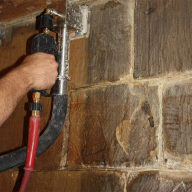Construction (Crucifixion), Bronze with colour 1966-67, a sculpture by Barbara Hepworth, is located within the grounds of Salisbury Cathedral. It was gifted to Salisbury in 1969 and has seen periods of time at Portsmouth and Winchester Cathedrals, before returning to Salisbury in 2017.
THE PROBLEM
Despite numerous conservation and restoration treatments over the years to give added length of life to the original 1960s’ paint, this had eventually begun to fail. The surfaces of the unpainted bronze sections of the sculpture were coated in a thick dark wax, which was not in keeping with the original finish of the work and masked areas that actually were painted black.
When the paint was deemed in sufficiently poor condition, with peeling parts and UV damage affecting its colour, the restoration and cleaning of the artwork was seen to be the right move. This decision was made in agreement with the Hepworth Estate. All the wax and paint needed to be removed, and the surface restored back to as close to the original artist’s finish as possible.
THE SOLUTION
The ThermaTech superheated water system was used to remove wax from the surface of the sculpture, followed by removal of as much of the paint as possible using the same method. Some of the more stubborn layers of paint first had a paint softener applied, at which point removal with the superheated water was then able to take place.
The paint removed that was undamaged by UV and closest to the bronze surface was vital in acting as samples used for colour matching in the restoring process. Extensive research was undertaken to ascertain the correct colour for the work to match the originals used in the 1960s’ finish.
THE OUTCOME
With the use of the ThermaTech super-heated water system, the wax and paint were removed delicately without causing damage to the surface of the sculpture.
Without all of the dark wax obscuring the bronze, the original fluctuating colour was once again able to be seen.
The paint removed aided and confirmed in the choices for new paint, to ensure there was no doubt that the artwork was being restored as close as possible to the finish by the artist in the 1960s.
Restorative Techniques' ThermaTech Restores Barbara Hepworth Sculpture
| T | (01454) 417831 |
|---|---|
| F | (01454)412445 |
| E | info@restorativetechniques.co.uk |
| W | Visit Restorative Techniques Ltd's website |
| UK & Worldwide, Gloucester Road, Rudgeway, Bristol, BS35 3SG |


-file147453.png)



